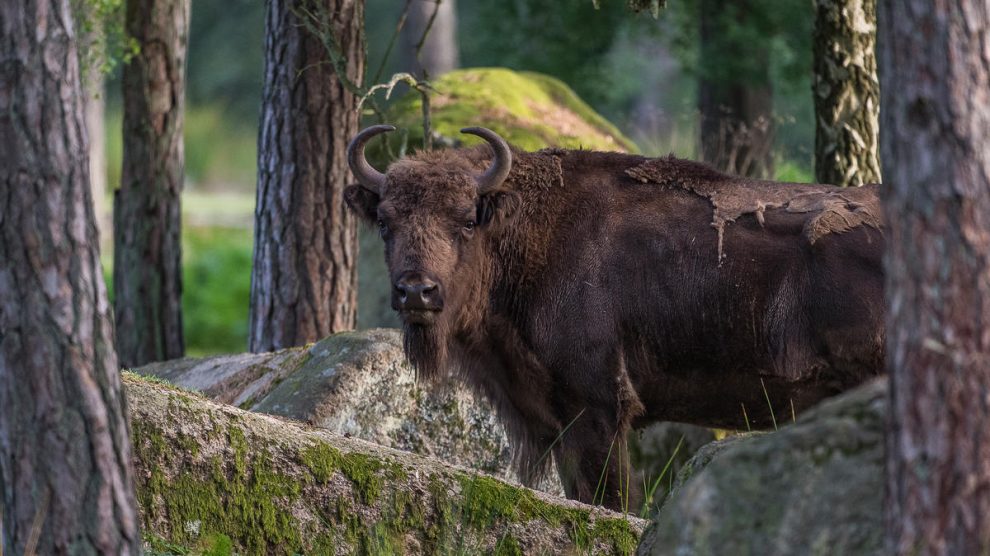The European bison population in Ukraine’s Zalissia National Nature Park is facing the threat of extinction due to Russia’s war. Finding mates for the endangered female herd is now critical to their survival.
Humanity has shown remarkable creativity in its pursuit to decode the algorithm of love and thus diminish loneliness worldwide. Romantic introductions through reality shows, apps, speed dating, Cupid consultants—you name it. All of them aimed at helping individuals find their match.
Now, that same level of creativity is urgently needed to protect Ukraine’s wildlife, particularly its bison population, from the devastating impacts of war.
- Despite Russia’s invasion, conservation work in Ukraine continues
- Assessing the environmental impact of the war in Ukraine
- Russia’s war on Ukraine: Five essential reads
What’s love got to do with it? The Zalissia National Nature Park is home to a herd of bison. Their home, along with the adjacent villages, was an area of intense fighting in the first months of the Russian war on Ukraine. The war affected the general status of European bison in Zalissia—not a single adult male survived. Finding a match for the lonesome female herd is now critical to their survival.
Yet long-distance relationships do not work for the bison. According to WWF Central and Eastern Europe, two male bison from the Vinnytsia region west of Kyiv can save the herd in Zalissia, but to do so, the animals have to travel about 300 km and around Kyiv—a difficult journey that they cannot do on their own.
“Relocating any animal, even a domestic one, requires careful preparation and time. Relocating Europe’s largest land animal will require a year of coordinated action and an initial 10,000 euros. The bison need our help,” says Dr Bohdan Vykhor, CEO of WWF Ukraine, inviting people across Europe to donate for the cause as part of the campaign ‘300km to love and saving bison’.
The threat to the bison population in Zalissa is one of the numerous unprecedented environmental impacts of Russia’s war.
While it is too early for a comprehensive assessment, there are already worrying indications of the nature and scope of the damage that is growing with each day of the Russian war in Ukraine. The environmental costs include direct impacts on habitats and species, such as the bison, but are not limited to them; indirect costs include pollution of air, land, and water, or the diversion of resources away from the environmental cause.
One of the world’s most threatened mammals
The bison were brought to the territory of Zalissia National Nature Park in 1967 from the Białowieża Forest in Poland. Eight animals formed the Zalissia subpopulation, which still lives in semi-free conditions. The fenced area of the reserve is huge—14,800 hectares—but in March 2022, a significant part of the area was destroyed as a result of the war.
In the 17th – 19th centuries, European bison were driven to the edge of extinction by excessive and uncontrolled hunting. In most European countries, including Ukraine, European bison went completely extinct in the wild. Due to rigorous conservation efforts, bison are slowly returning to European natural forest landscapes and contributing to a healthy and diverse ecosystem.
“The European bison is one of the most threatened large mammals in the world, and it is protected at the European level. WWF is working to reintroduce bison in the region. After a long absence, this can not only revive populations of this threatened species but also enrich and restore remaining wild landscapes in Europe,” says Irene Lucius, Regional Conservation Director for WWF Central and Eastern Europe.
While browsing in search of food, bison help maintain a mosaic of forested areas and grasslands—a landscape that is highly valuable for its biodiversity and natural resilience in the face of climate challenges. Moreover, the bison is a species that, if successfully re-introduced and its habitat actively preserved, will help maintain ecological corridors on a large scale, allowing for species migration, including large carnivores such as the brown bear, the wolf, or the lynx.
Photo: © Ola Jennersten / WWF-Sweden
Unlike many news and information platforms, Emerging Europe is free to read, and always will be. There is no paywall here. We are independent, not affiliated with nor representing any political party or business organisation. We want the very best for emerging Europe, nothing more, nothing less. Your support will help us continue to spread the word about this amazing region.
You can contribute here. Thank you.



Add Comment